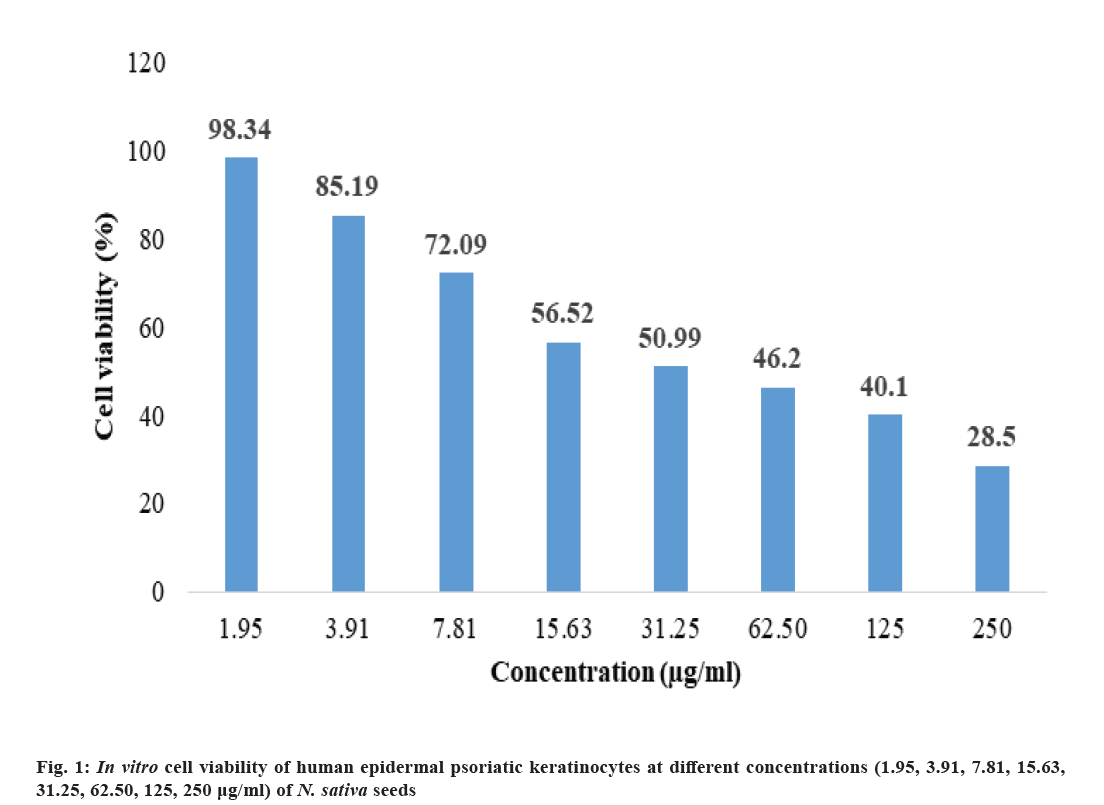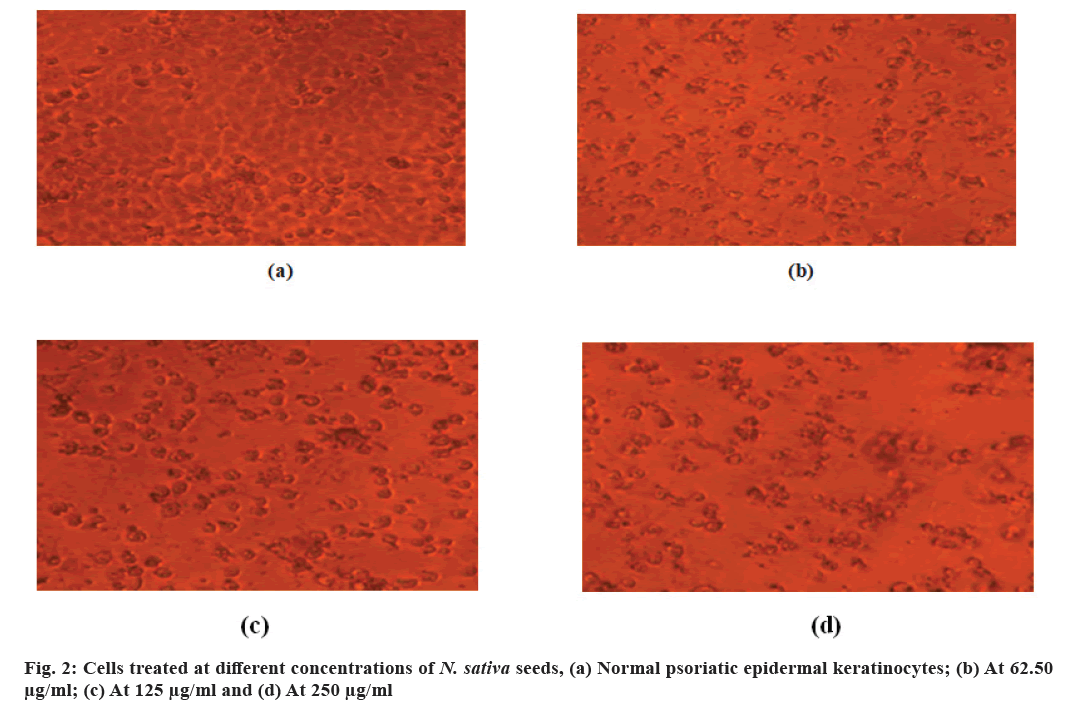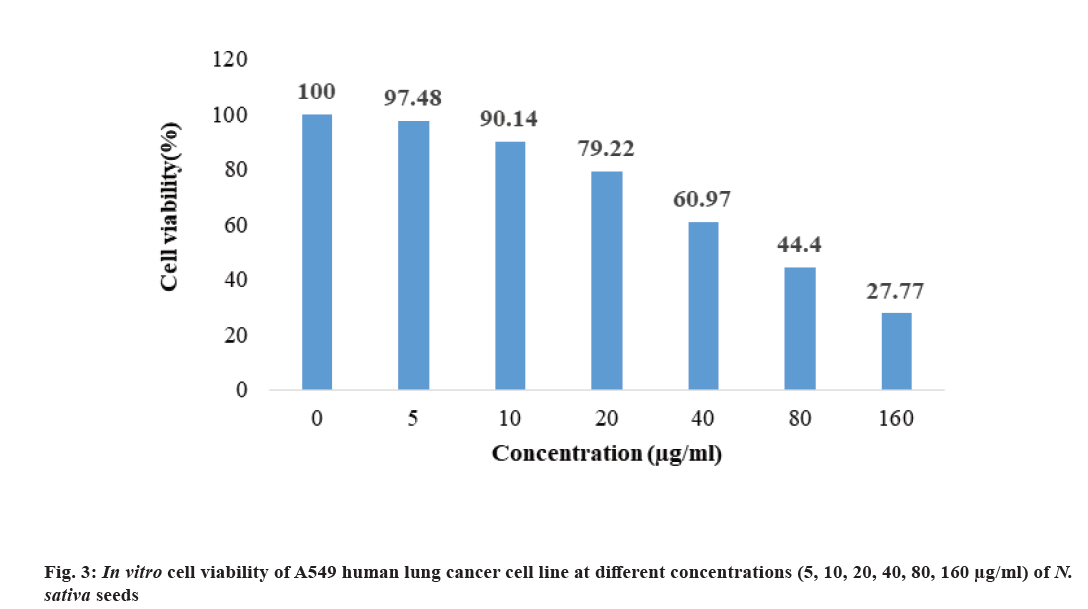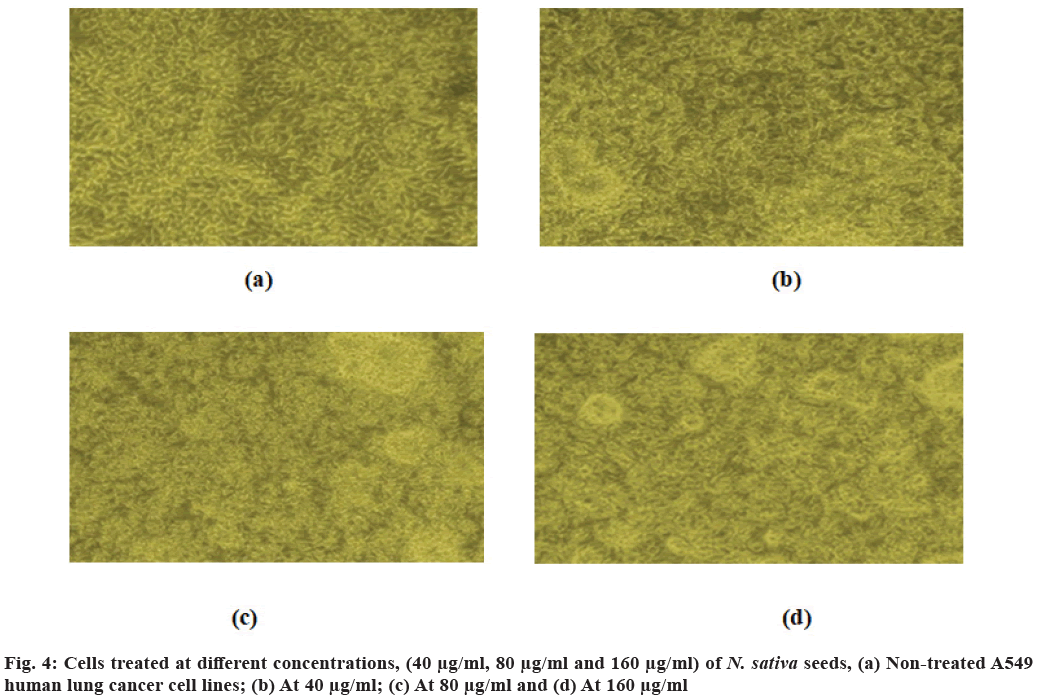- *Corresponding Author:
- Nora Vigasini
Department of Home Science, Women’s Christian College, University of Madras, Nungambakkam, Chennai 600006, India
E-mail: noravigasini267@gmail.com
| Date of Received | 05 May 2021 |
| Date of Revision | 15 September 2021 |
| Date of Acceptance | 18 July 2022 |
| Indian J Pharm Sci 2022;84(4):883-889 |
This is an open access article distributed under the terms of the Creative Commons Attribution-NonCommercial-ShareAlike 3.0 License, which allows others to remix, tweak, and build upon the work non-commercially, as long as the author is credited and the new creations are licensed under the identical terms
Abstract
Psoriasis is a chronic inflammatory skin disease with immense physical, biological and psychological implications which puts a person at high risk for developing cancers like lung cancer. The aim of the study was to determine the effectiveness of Nigella sativa seeds as an effective antioxidant that can prevent the proliferation of psoriatic epidermal keratinocytes and lung cancer cells. Quantitative determination of phenols, flavonoids and antioxidant activities were performed using Folin-Ciocalteu colorimetric method, aluminium chloride colorimetric method and hydroxyl radical scavenging assay respectively. In vitro antiproliferative assay against psoriatic epidermal keratinocytes and A549 human lung cancer cell lines were determined using 3-(4,5-dimethylthiazol-2yl)-2,5-biphenyl tetrazolium bromide assay. Nigella sativa seeds were found to possess good amount of phenols and flavonoids. The hydroxyl radical scavenging activity was observed to be 79.15 %±0.29 % at 120 μg/ml. The maximum cytotoxicity on psoriatic keratinocytes was found to be 71.50 %±0.74% at 250 μg/ml and half-maximal inhibitory concentration was calculated to be 31.8 μg/ml. Maximum cytotoxicity on A549 human lung cancer cell lines of 72.22 %±0.80 % was observed at 160 μg/ml and half-maximal inhibitory concentration was calculated to be 71.94 μg/ml. From these observations, it is evident that Nigella sativa seeds have excellent antioxidant, antipsoriatic and anticancer activities. This makes it a promising safe herbal based therapy in the treatment of psoriasis in comparison to commercially available drugs with adverse side effects.
Keywords
Antioxidant, antipsoriatic activity, antiproliferative, psoriasis, cytotoxicity
Psoriasis is a chronic inflammatory disease characterized by pathological skin lesions[1]. It affects men and women of all ages. The overall prevalence of psoriasis ranges from 0.09 % to 11.4 %. The prevalence rates range between 1.65 % and 5 % in developing countries. Recent studies indicate an increasing trend in the prevalence of psoriasis[2]. Some of the symptoms of psoriasis are scaling of the skin, itching, erythema, fatigue, swelling, burning and bleeding[3]. In addition to the skin and nails, localized body regions like hands, feet, facial and genital regions are also affected. A lot of physical, psychological, social and functional implications are associated with the disease. Studies have shown that psoriatic patients have an increased risk of lung cancer[4].
Oxidative stress plays an important role in the pathogenesis of many chronic degenerative diseases including psoriasis. Psoriasis is characterized by an oxidant-antioxidant imbalance which is aggravated by the increase in oxidative stress[5]. Due to the unpleasant side effects of commercially available drugs, traditional and natural remedies are preferred by many. This suggests the importance of treating such conditions with effective natural antioxidants. The present study focuses on the efficiency of Nigella sativa (N. sativa) seeds as a natural antioxidant, antipsoriatic and anticancer drug. Natural remedies are of recent interest owing to the unpleasant side effects of the commercially available drugs. N. sativa seeds vary in their phenolic and flavonoid content according to the geographical origin[6]. Studies on the Indian variety of N. sativa seeds are sparse.
To evaluate the antipsoriatic and anticancer activity of the sample, the determination of phenols, flavonoids and antioxidant activity were necessary to understand the role of N. sativa seeds in reducing oxidative stress- related diseases like psoriasis and lung cancer. Phenols and flavonoids are the major antioxidants present in plant species[7,8]. These compounds are important in determining the radical scavenging or antioxidant activity of the sample. The degree of antiproliferative activity on psoriatic epidermal keratinocytes and lung cancer cells is dependent upon the antioxidant activity of the sample. The objectives of the present study were to determine the total phenolic and flavonoid content, In vitro antioxidant, antipsoriatic and anticancer activities of N. sativa seeds.
Materials and Methods
Preparation of the sample:
N. sativa seeds of Indian origin were purchased from the local markets of Tamil Nadu. The plant material was authenticated from the Department of Botany, Rashtrasant Tukadoji Maharaj (RTM) Nagpur University, Nagpur (authentication no.10451). N. sativa seeds were ground in a blender and macerated in methanol for 72 h. The supernatant was filtered using Whatman’s filter paper No 8. A stock solution of 1 mg/ ml was prepared using methanol.
Determination of total phenols:
The concentration of phenols was determined by the Folin-Ciocalteu colorimetric assay. This assay was performed with minor modifications. 100 μl of methanolic extract (1 mg/ml) was added with 900 μl of methanol and 1 ml of Folin-Ciocalteu reagent (1:10 dilution with distilled water). After 5 min, 1 ml of 20 % sodium carbonate was added to the solution and mixed well. The samples were prepared in triplicates and were incubated in dark at room temperature for 30 min. The absorbance was determined using Ultraviolet-Visible (UV-Vis) spectrophotometer at 765 nm. The same procedure was repeated for the standard solution of gallic acid. The content of phenolics in the extract was expressed in terms of Gallic Acid Equivalents (GAE) (μg/mg of the extract)[9]. The result was represented as mean±Standard Deviation (SD).
Determination of flavonoids:
The content of flavonoids was determined using aluminium chloride colorimetric assay. The sample contained 500 μl of methanol and 500 μl of extract solution (1 mg/ml). It was mixed with 0.5 ml of 5 % sodium nitrite solution and incubated for 5 min at room temperature. 500 μl of 10 % of aluminium chloride solution was added and incubated further for 5 min at room temperature. This was followed by the addition of 1 ml of 1 M Sodium hydroxide (NaOH) solution. The total volume was made upto 5 ml, mixed well and incubated at room temperature for 30 min. Absorbance was measured at 510 nm using UV-Vis spectrophotometer. The samples were prepared in triplicates and the mean value of absorbance was obtained. The same procedure was repeated for the standard solution of quercetin. The content of flavonoids in the extract was expressed in terms of Quercetin Equivalents (QUE) (μg/mg of the extract)[10]. The result was represented as mean±SD.
Determination of In vitro antioxidant activity by hydroxyl radical scavenging assay:
Excess generation of reactive oxygen species like hydroxyl radicals occurs in the biological membranes during oxidative stress. Hydroxyl radicals are produced in the presence of hydrogen peroxide and iron ions by Haber-Weiss reaction[11]. In vitro antioxidant activity was determined by hydroxyl radical scavenging assay. Various concentrations of the sample (20, 40, 60, 80, 100, 120 μg/ml) was made upto 1 ml with methanol. This was followed by 500 μl of 9 mM salicylic acid, 500 μl of 9 mM ferrous sulphate and 50 μl of 9 mM hydrogen peroxide solution. The solution was incubated at 37° for 1 h. Absorbance was calculated at 510 nm. This procedure was repeated for ascorbic acid at smaller concentrations (2, 4, 6, 8, 10, 12 μg/ml). The radical scavenging activity was calculated using the formula:
Percent (%) radical scavenging activity=Absorbance of control-Absorbance of sample/Absorbance of control×100.
The procedure was done in triplicates. The mean average % radical scavenging activity and SD were taken.
In vitro antiproliferative activity of N. sativa seeds on psoriatic keratinocytes and A549 human lung cancer cell line:
In vitro antiproliferative effect of methanolic extract of N. sativa seeds was determined using 3-(4,5-Dimethylthiazol-2yl)-2,5-biphenyl Tetrazolium Bromide (MTT) assay. It is a colorimetric assay commonly done to evaluate cell viability. Human epidermal keratinocytes (psoriatic model) were seeded in 5×103 cells in 96-well plates for 24 h, in 200 μl of Roswell Park Memorial Institute (RPMI) with 10 % Fetal Bovine Serum (FBS). The supernatant of the cell culture was removed and RPMI containing various concentrations of the sample (1.95, 3.91, 7.81, 15.63, 31.25, 62.50, 125, 250 μg/ml) was added and incubated for 48 h. After the incubation period, the psoriatic epidermal keratinocyte cell culture was incubated with MTT at 37° for 4 h. This was then incubated with Dimethyl Sulfoxide (DMSO) at room temperature for 1 h. The colour changes in the wells were noted and absorbance was read at 595 nm on an Enzyme-Linked Immunosorbent Assay (ELISA) reader. The procedure was repeated for A549 human lung cancer cell lines and the test compound was added at concentrations of 20, 40, 60, 80, 100 and 120 μg/ml[12].
Percent (%) cytotoxicity and cell viability were calculated using the following formula:
Cytotoxicity (%)=Absorbance of control-Absorbance of sample/Absorbance of control×100.
Cell viability (%)=100-% cytotoxicity.
The antiproliferative results for both human epidermal keratinocytes and A549 human lung cancer cell line were represented as mean±SD.
Results and Discussion
Phenols and flavonoids are the major phytochemical constituents found in plants. Previous studies have proven that phenolic compounds are potentially effective in the treatment of various skin disorders[11]. In the present study, the total phenolic and flavonoid content in the methanolic extract of N. sativa seeds was found to be 234±0.129 μg/mg GAE and 143.76±1.145 μg/mg QUE respectively. Results were expressed as mean±SD.
The results of the present study were similar to the study done among N. sativa seeds from Pakistan where the phenols and flavonoids were observed to be 292.5±9.1 mg/GAE and 188.8±5.7 mg/QUE[13] respectively. A comparative study done between Ethiopian type seeds and Indian type seeds was around 542.56±1.50 GAE and 437.00±1.27 GAE respectively[14].
Hydroxyl radical scavenging assay of N. sativa seeds revealed an increasing trend in the level of radical scavenging activity. The results were found to be dose-dependent which proved that the sample was able to effectively scavenge the free radicals. This was compared with ascorbic acid as standard. Maximum hydroxyl radical scavenging activity was observed to be 79.15 %±0.29 % at 120 μg/ml for N. sativa seeds. Half-maximal Inhibitory Concentration (IC50) was observed to be 79 μg/ml for N. sativa seeds and 6.41 μg/ml for ascorbic acid. The % inhibition of hydroxyl radical at different concentrations of sample and standard are listed in Table 1. The adequate amounts of phenols and flavonoids may be able to influence the radical scavenging activity of the sample.
| S. No. | Concentration of N. sativa seeds (μg/ml) | Percent growth inhibition by N. sativa seeds (Mean±SD) | Concentration of ascorbic acid (μg/ml) | Percent growth inhibition by ascorbic acid (Mean±SD) |
|---|---|---|---|---|
| 1 2 3 4 5 6 7 |
Control 20 40 60 80 100 120 |
0 11.89±3.57 33.82±0.39 45.62±0.39 50.63±0.20 59.29±0.35 79.15±0.29 |
Control 2 4 6 8 10 12 |
0 13.74±0.10 32.82±0.25 46.76±5.30 61.8±0.08 74.38±0.14 79.67±0.26 |
Note: In vitro antioxidant activity of N. sativa seeds at different concentrations (20, 40, 60, 80, 100, 120 μg/ml) is represented as mean±SD. In vitro antioxidant activity of standard ascorbic acid at different concentrations (2, 4, 6, 8, 10, 12 μg/ml) is represented as mean±SD
Hydroxyl radical is a highly reactive biological radical. During oxidative stress, a human cell is attacked by hydroxyl radicals and other reactive oxygen species on an average of 105 times[15,16]. Hydroxyl radicals have a major role to play in increasing the severity of oxidative stress-mediated diseases like psoriasis[17]. The results established that N. sativa seeds are effective in scavenging highly reactive hydroxyl radical and may be effective in treating oxidative stress in psoriasis and cancers.
In vitro antiproliferative activity of N. sativa seeds on psoriatic keratinocytes and A549 human lung cancer cell line is as follows. MTT assay revealed a dosedependent increase in the antiproliferative activities of the sample against psoriatic keratinocytes and A549 human lung cancer cell lines.
In vitro antiproliferative activity on human epidermal keratinocytes (psoriatic model) is explained here. Fig. 1 depicts a decrease in the cell viability when the psoriatic keratinocytes were treated with the sample in increasing concentrations. The maximum cytotoxicity on psoriatic keratinocytes was found to be 71.50±0.74 at 250 μg/ml concentration and IC50 was calculated to be 31.8 μg/ml.
Fig. 2a represents normal human epidermal psoriatic keratinocyte cells. Fig. 2b-fig. 2d represents cells treated with N. sativa seeds at 62.50 μg/ml, 125 μg/ ml and 250 μg/ml concentrations respectively. These findings suggest that even at low concentrations, N. sativa seeds were found to be effective and safe against human psoriatic keratinocyte cells.
In vitro antiproliferative activity on A549 human lung cancer cell lines is as follow. A dose-dependent decrease in cell viability was also observed in A549 human lung cancer cell lines when treated with methanolic extract of N. sativa seeds. Fig. 3 represents the cell viability when treated with different concentrations of the sample. The maximum cytotoxicity was observed to be 72.23 %±0.80 % at 160 μg/ml. IC50 was found to be 71.94 μg/ml. Fig. 4a-fig. 4d represents nontreated A549 human lung cancer cell lines and sample treated cancer cell lines. A significant difference could be observed in the intactness of these cells at a higher concentration of the sample.
Even though the average of maximum cytotoxicity percent for psoriatic keratinocytes and lung cancer cell lines was observed to be 71.86 %, IC50 value was found to be much higher for lung cancer cell lines than psoriatic keratinocytes. This means that there is a higher antiproliferative potential of N. sativa seeds to inhibit the psoriatic keratinocytes by 50 % when compared to lung cancer cells. The main bioactive compound in N. sativa seeds is a phenolic compound called thymoquinone, which is responsible for antipsoriatic activities[18]. A recent review article found that flavonoids are a promising therapy in the treatment of lung cancers[19]. In the present study, N. sativa seeds contain a higher amount of phenols when compared to flavonoids which may have resulted in a higher antiproliferative activity against psoriatic keratinocytes when compared to lung cancer cells. Although there is a difference in the phenol and flavonoid content, many of the flavonoids are phenolic compounds.
Several antipsoriatic drugs like methotrexate, cyclosporine in the market have been reported serious side effects like nausea, vomiting, diarrhea, hepatotoxicity, hyperplasia, nephrotoxicity, hypertension, hypercholesteremia, hypomagnesemia, hyperkalemia, numerous drug interactions, skin cancers and lymphoma[20,21]. There is an urgent need to find alternative natural herbal products for treating psoriasis since they do not produce any adverse side effects and are safe. This study proves that N. sativa seeds possess excellent antioxidant and antiproliferative activities on A549 lung cancer cell line and psoriatic keratinocytes, owing to the synergistic effect of antioxidants especially phenols and flavonoids. N. sativa seeds of Indian origin also possess good amounts of phenols and flavonoids, which are effective antioxidants. They can be used to treat oxidative stress which is one of the causative factors in the development and prognosis of psoriasis. Both topical application and oral administration of N. sativa seeds may be recommended in treating psoriasis and its complications in the future.
Acknowledgements:
The author acknowledges Armats Biotek Training and Research Institute, Chennai for providing the lab facility and resources for the conduction of the study.
Conflict of interests:
The authors declared no conflict of interest.
References
- Rendon A, Schäkel K. Psoriasis pathogenesis and treatment. Int J Mol Sci 2019;20(6):1475.
[Crossref] [Google scholar] [PubMed]
- Danielsen K, Olsen AO, Wilsgaard T, Furberg AS. Is the prevalence of psoriasis increasing? A 30‐year follow‐up of a population‐based cohort. Br J Dermatol 2013;168(6):1303-10.
[Crossref] [Google scholar] [PubMed]
- Pariser D, Schenkel B, Carter C, Farahi K, Brown TM, Ellis CN, et al. A multicenter, non-interventional study to evaluate patient-reported experiences of living with psoriasis. J Dermatolog Treat 2016;27(1):19-26.
[Crossref] [Google scholar] [PubMed]
- Fuxench ZC, Shin DB, Beatty AO, Gelfand JM. The risk of cancer in patients with psoriasis: A population-based cohort study in the health improvement network. JAMA Dermatol 2016;152(3):282-90.
[Crossref] [Google scholar] [PubMed]
- Cannavo SP, Riso G, Casciaro M, Di Salvo E, Gangemi S. Oxidative stress involvement in psoriasis: A systematic review. Free Radic Res 2019;53(8):829-40.
[Crossref] [Google scholar] [PubMed]
- Amina B. Toxicity and anti-oxidant activity of the essential oil of Nigella sativa. Der Pharm Lett 2016;8(15):245-9.
- Singh DP, Verma S, Prabha R. Investigations on antioxidant potential of phenolic acids and flavanoids: The common phytochemical ingredients in plants. J Plant Biochem Physiol 2018;6(3):1-5.
- Tungmunnithum D, Thongboonyou A, Pholboon A, Yangsabai A. Flavonoids and other phenolic compounds from medicinal plants for pharmaceutical and medical aspects: An overview. Medicines 2018;5(3):93.
[Crossref] [Google scholar] [PubMed]
- Vardhini SP, Sivaraj C, Arumugam P, Ranjan H, Kumaran T, Baskar M. Antioxidant, anticancer, antibacterial activities and GCMS analysis of aqueous extract of pulps of Aegle marmelos (L.) Correa. J Phytopharmacol 2018;7(1):72-8.
- Das TK, Wati MR, Fatima-Shad K. Oxidative stress gated by Fenton and Haber Weiss reactions and its association with Alzheimer’s disease. Arch Neurosci 2015;2(2):e60038.
- Bahuguna A, Khan I, Bajpai VK, Kang SC. MTT assay to evaluate the cytotoxic potential of a drug. Bangladesh J Pharmacol 2017;12(2):115-8.
- Działo M, Mierziak J, Korzun U, Preisner M, Szopa J, Kulma A. The potential of plant phenolics in prevention and therapy of skin disorders. Int J Mol Sci 2016;17(2):160.
- Hameed S, Imran A, Nisa MU, Arshad MS, Saeed F, Arshad MU, et al. Characterization of extracted phenolics from black cumin (Nigella sativa Linn), coriander seed (Coriandrumsativum L.) and fenugreek seed (Trigonella foenum-graecum). Int J Food Prop 2019;22(1):714-26.
- Thilakarathne RC, Madushanka GD, Navaratne SB. Phytochemical analysis of Indian and Ethiopian black cumin seeds (Nigella sativa). Agric Res Technol 2018;17(1):1-6.
- Kumar S, Pandey AK. Free radicals: Health implications and their mitigation by herbals. Br J Med Med Res 2015;7(6):438-57.
- Collin F. Chemical basis of reactive oxygen species reactivity and involvement in neurodegenerative diseases. Int J Mol Sci 2019;20(10):2407.
[Crossref] [Google scholar] [PubMed]
- Asha K, Singal A, Sharma SB, Arora VK, Aggarwal A. Dyslipidaemia and oxidative stress in patients of psoriasis: Emerging cardiovascular risk factors. Indian J Med Res 2017;146(6):708-13.
[Crossref] [Google scholar] [PubMed]
- Okasha EF, Bayomy NA, Abdelaziz EZ. Effect of topical application of black seed oil on imiquimod‐induced psoriasis‐like lesions in the thin skin of adult male albino rats. Anat Rec 2018;301(1):166-74.
[Crossref] [Google scholar] [PubMed]
- Forni C, Rossi M, Borromeo I, Feriotto G, Platamone G, Tabolacci C, et al. Flavonoids: A myth or a reality for cancer therapy? Molecules 2021;26(12):3583.
[Crossref] [Google scholar] [PubMed]
- Kim WB, Jerome D, Yeung J. Diagnosis and management of psoriasis. Can Fam Physician 2017;63(4):278-85.
[Google scholar] [PubMed]
- Liu HQ, Wang YM, Li WF, Li C, Jiang ZH, Bao J, et al. Anti-psoriasis effects and mechanisms of Α-(8-quinolinoxy) zinc phthalocyanine-mediated photodynamic therapy. Cell Physiol Biochem 2017;44(1):200-14.
[Crossref] [Google scholar] [PubMed]



